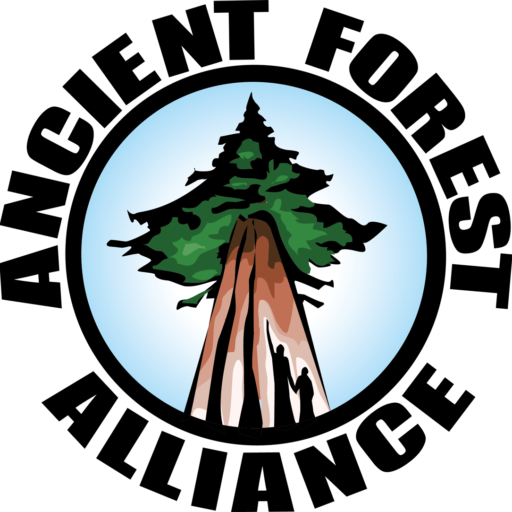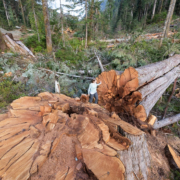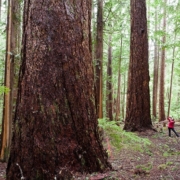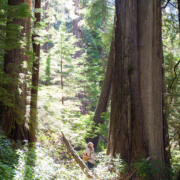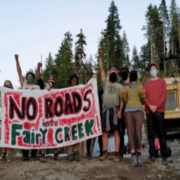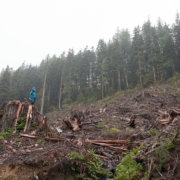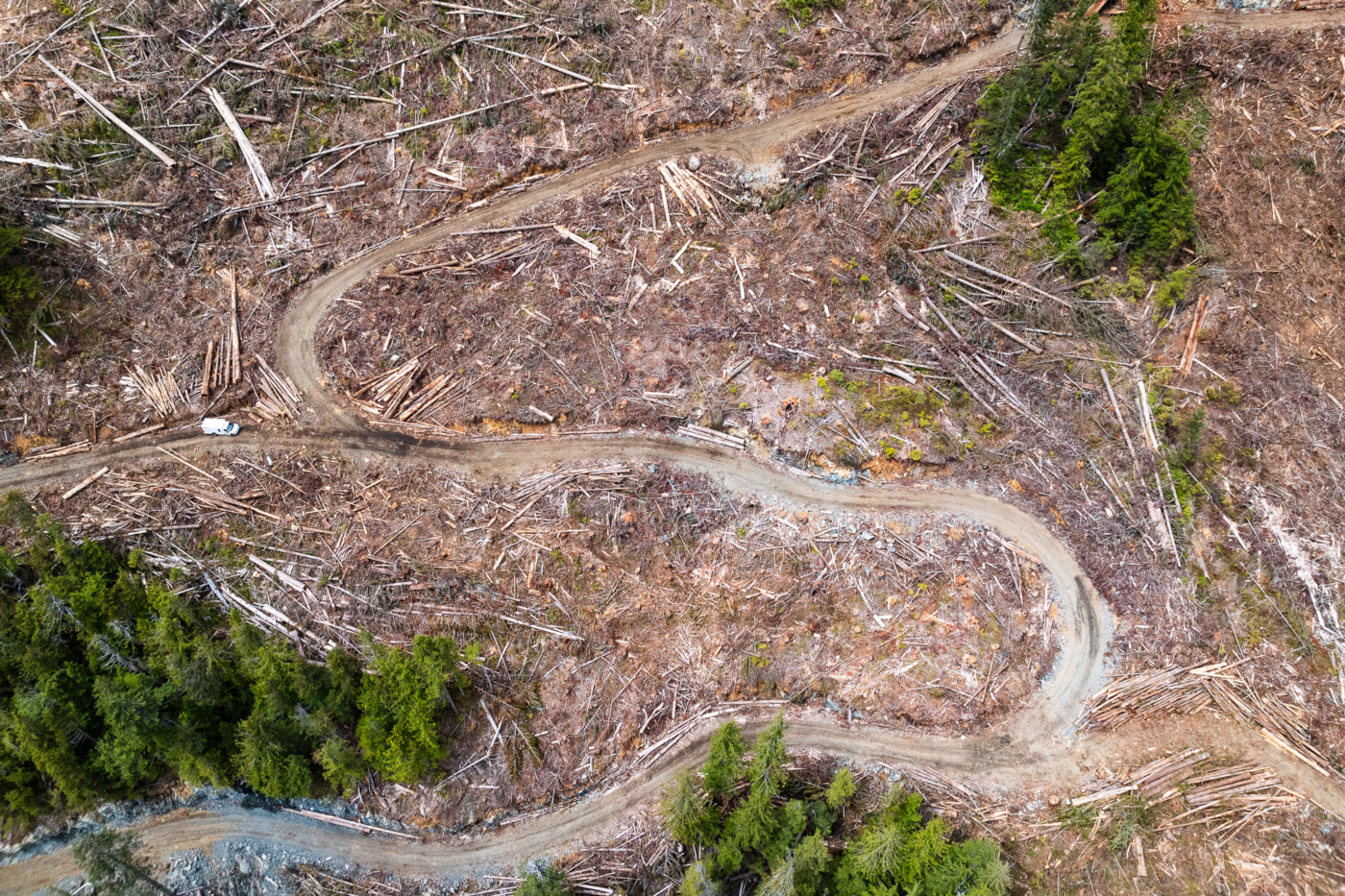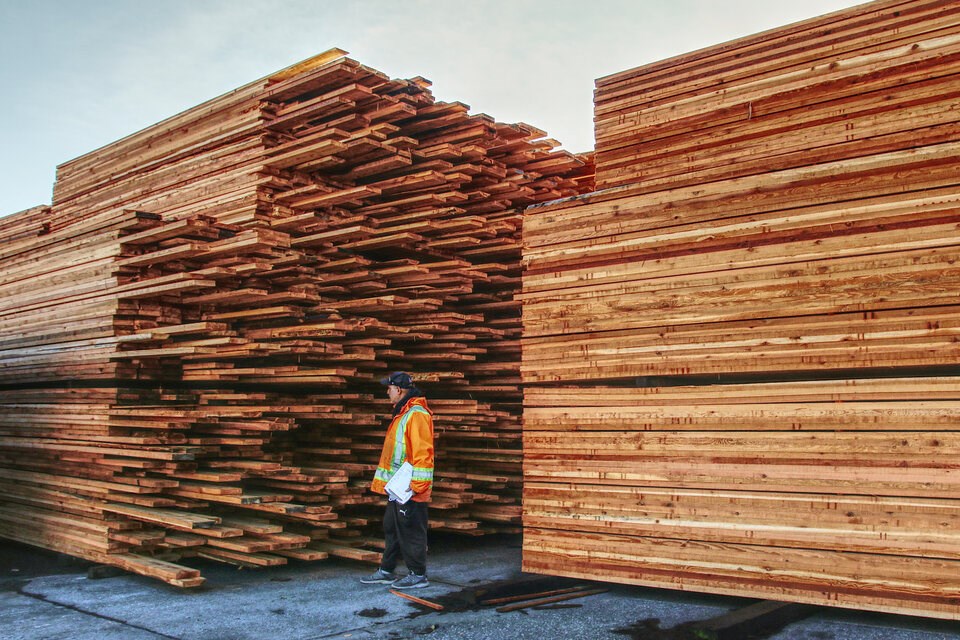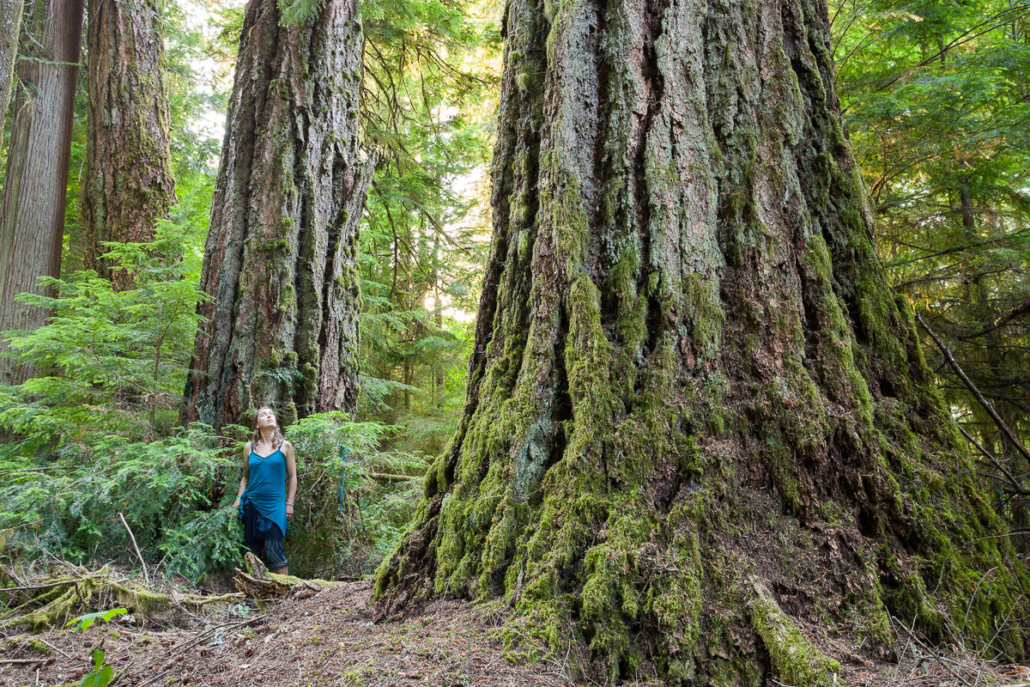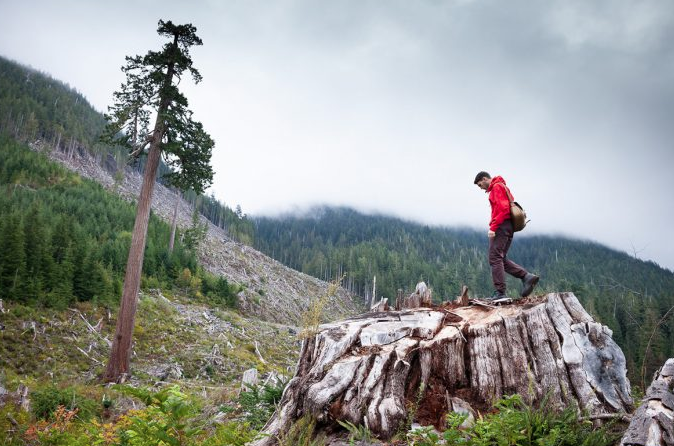 Oct 3 2019
Oct 3 2019A Closer Look at B.C. Forestry and Tall Tree Tourism
Douglas Magazine
October 3rd, 2019
Old-growth logging and raw-log exports continue on Vancouver Island, but critics say big-tree tourism is a far more sustainable economic force for our future.

A few determined rays of sunlight pierced to the forest floor, illuminating electric green moss in pools of light. Branches, filigreed with lichen, arced above like the flying buttresses of a Gothic cathedral.
Watt was moved by the sheer beauty of these old-growth giants and also by the realization that most Vancouver Island valley bottoms, like the Walbran, located outside of existing parks and protected areas, had already been razed to stumps and replaced with relatively scraggly second growth.
Roughly 1.5 million hectares, or about 75 per cent of the original two million hectares of productive old-growth forest on Vancouver Island has been cut, according to the conservation group Ancient Forest Alliance.
“Going to the Walbran completely blew my mind. Walking through this forest with thousand-year-old trees was stunning,” says Watt, who grew up in Metchosin and was no stranger to places of natural beauty. “But we had driven through miles and miles of clear cut forest to get there.”
Four years later, he and a friend were driving up and down logging spurs in search of tall trees in the Cowichan Valley, a part of southern Vancouver Island that boosted the past fortunes of logging giants like MacMillan Bloedel.
Toward the end of a so-far-fruitless day of big-tree hunting, they neared Port Renfrew and spotted huge cedar candelabras poking above the canopy next to the Gordon River. They drove up a side road for a few kilometres, parked, then walked downhill, back toward the river, into an almost magical world.
“I knew right away we had found something special,” Watt recalls about the moment he first encountered the cedars of what would soon become known as Avatar Grove.
It was remarkable given that this grove of massive trees was less than a half hour’s drive from Port Renfrew, on a road that almost anyone could manage in a low clearance, two-wheel-drive vehicle, yet likely wasn’t known by anyone other than some foresters and local Indigenous Pacheedaht people.
Avatar Grove, named for the then just-released James Cameron blockbuster movie, proved Watt’s knack for coming up with catchy and marketable names. (Recently, he was party to another big tree find near Port Renfrew, this one of moss-covered maples and Douglas firs — they called it Mossome Grove.) It triggered a feverish conservation campaign and the launch of a new non-profit, The Ancient Forest Alliance, with fellow activist Ken Wu.
“It was wild. People started visiting Avatar [Grove] by the thousands, and media coverage went viral — locally, nationally and internationally,” Watt says.
The rest is history. Avatar Grove got protected, and its international popularity eventually resulted in sleepy Port Renfrew rebranding itself as the “Tall Tree Capital of Canada.”
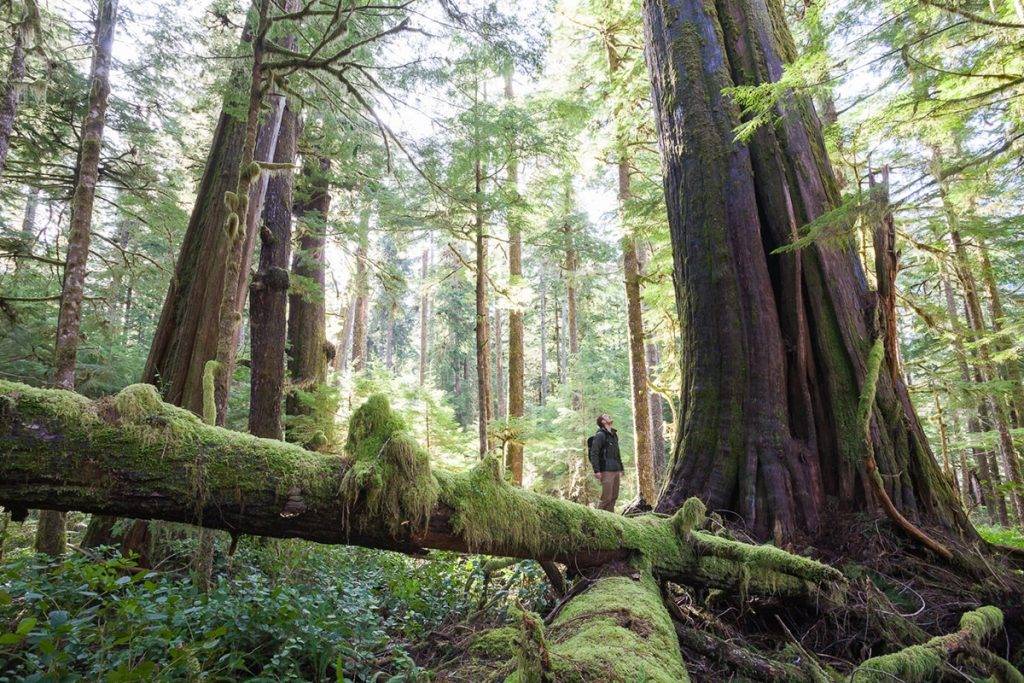
Thanks in large part to the tall-tree hunting efforts of Watt, fellow conservationist Ken Wu and others, more and more people, and not just tree hunters, are beginning to view big trees left standing as more economically valuable than trees that have been cut down and turned into lumber and paper. It’s also a sign of the times.
Raw Logs: What’s the Reality?
Vancouver Island’s forest sector is far from what it used to be. Local manufacturing capacity was in decline even before 2003 when Gordon Campbell’s Liberal government scrapped a provision in the Forest Act called appurtenance — the requirement that companies with tenures to harvest Crown forest, or publicly owned forest, must operate mills in communities located within the geographical area of given tenures.
In a 2018 study for the Canadian Centre for Policy Alternatives, longtime forest policy analyst and former Vancouver Sun journalist Ben Parfitt took a sweeping look at raw-log exports and mill closures. Between 2013 and 2016, approximately 26 million cubic metres of raw logs were shipped out of B.C., and old growth accounts on average for half of raw-log exports. In 2016, the volume of raw log exports jumped 6.2 per cent year-over-year, according to Parfitt’s research.
The three largest exporters of raw logs happen to be big players on Vancouver Island: Western Forest Products, Island Timberlands and TimberWest Forest Corporation. (TimberWest and Island Timberlands were affiliated in 2018 under the umbrella of Vancouver-based Mosaic Forest Management.)
In 2016, TimberWest, which owns 327,000 hectares of timberland on Vancouver Island, sent more than two million cubic metres of raw logs out of the province. As raw-log exports rise, manufacturing capacity stalls. Since 1997, roughly 100 mills have shut in B.C. Parfitt gathered numbers from BC Stats showing that the forest industry shed 22,400 jobs over the past decade, mostly in lumber and pulp and paper manufacturing. Parfitt’s math claims 3,600 of those job losses are due directly to raw-log exports.
The decline of Vancouver Island’s forest sector is writ large in Campbell River. In 2008, TimberWest shut its sawmill, putting 257 people out work, and the following year closed its sawdust, pulp and container board division, resulting in another 440 job losses. Then, in 2010, Catalyst Paper closed its Elk Falls paper mill and axed 350 workers from its payroll.
Today Campbell River, a city that’s proximate to some of the planet’s most productive temperate conifer forests, watches as barge and shiploads of raw logs sail past its shuttered mills destined for the Lower Mainland booms, many of them eventually shipped to offshore mills.
Parfitt says this decline has taken on an obscene twist at the Harmac Pacific pulp mill near Nanaimo where a dearth of fibre, a by-product of the sawmilling sector that was once plentiful on Vancouver Island, has forced the company to chip raw logs to feed its operations.
So what gives? Parfitt says the reasons are complex. The removal of appurtenance had an impact. Downward shifting global demand for newsprint and paper is partly to blame. However, many of the big companies like TimberWest have made conscious business decisions not to reinvest in modern coastal mills and instead go for the low value, easy dollar from raw-log exports. Though domestic buyers are supposed to have the right of first refusal to buy B.C. logs, exports continue to climb.
The B.C. government recently announced changes to the Forest Act that will give the province more control over forest tenures, and Premier John Horgan has even hinted at bringing back appurtenance.
Speaking at the annual Truck Loggers Association last January, Horgan noted that “employment on the coast has declined by about 40 per cent.
“Lumber production has dropped by 45 per cent, pulp production by 50 per cent,” Horgan said. “At the same time, log exports from Crown land have increased by nearly tenfold.”
But Parfitt believes a return to a local manufacturing regulation that died more than 15 years ago is a long shot and says the industry would likely fight it. He says he hasn’t heard anything substantive coming out of Victoria that will stem the tide of raw-log exports, curtail the cutting of increasingly rare Island old growth or stimulate investment in modern local mills, measures environmental groups like the Ancient Forest Alliance and the Wilderness Committee have been calling for in recent years. Pam Agnew is spokesperson for Vancouver-based Mosaic Forest Management, the firm that assumed management of timberlands owned by both TimberWest and Island Timberlands following an agreement struck in 2018. She is clear about the direction of these Island timber companies.
“We don’t manufacture. We sell logs to mills,” Agnew says.
According to Parfitt, there’s also a socio-demographic shift at play in once raw-resource-dependent communities that has resulted in forestry jobs and policy dropping from its position as public issue number 1 like it was back in the 1980s and early 1990s when the War in the Woods raged in Clayoquot Sound.
“Many people are moving to Vancouver Island to retire or for other lifestyle attributes like recreation,” Parfitt says. “The last thing they want is a new mill to open up in town.”
Forestry is Still a Factor
Still, all things considered, forestry hasn’t faded from Vancouver Island’s balance sheet. There are currently 140 wood-processing operations, employing 4,000 people and generating more than $1.7 billion in annual revenues, according to the Vancouver Island Economic Alliance (VIEA).
At a June 20 Island Wood Industry Forum sponsored by VIEA, the hot topics were improving access to fibre and stimulating value-added manufacturing, with specific focus on pressure-treated lumber, glulam and cross-laminated timber and wood-fibre insulation.
In April, as part of its forest-industry rejuvenation efforts, VIEA announced a $100,000 Waste Wood Recovery Project that will explore ways to better sort waste wood and make more of it available to manufacturers. The message from VIEA is that despite the transformation of Port Renfrew from resource to tall-tree tourism, there are still many Vancouver Island workers who derive a living directly or indirectly from forestry.
It’s bread and butter for Paul Beltgens, an industry veteran whose family founded Paulcan and Jemico Enterprises in Chemainus in the mid 1980s, specializing in the milling of both softwoods and local hardwoods, like maple and alder.
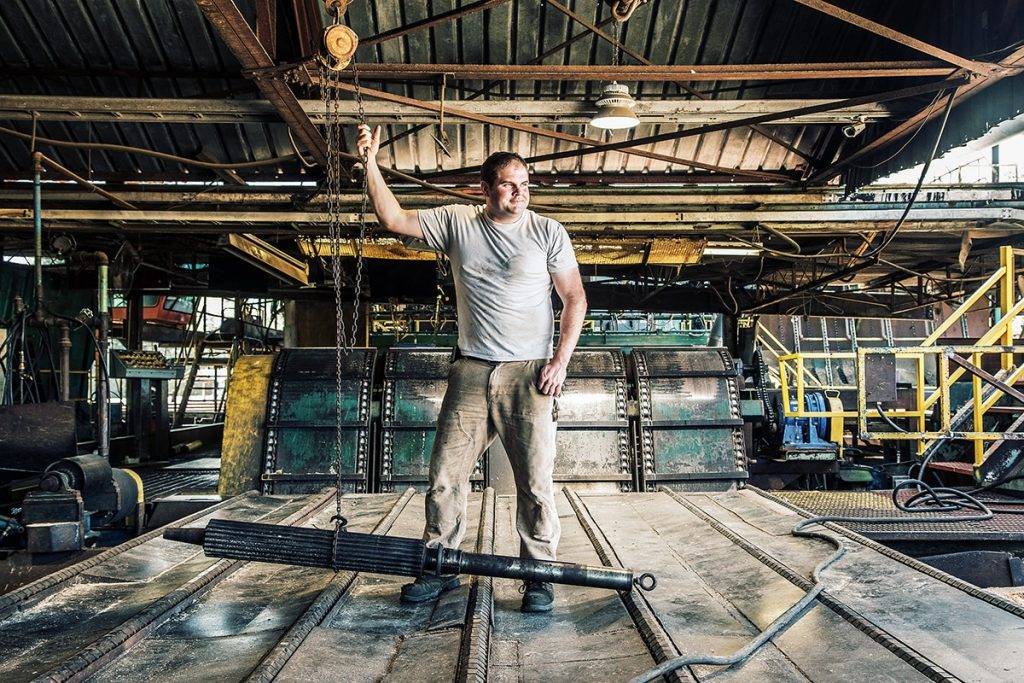
The exodus of manufacturing jobs in the form of raw-log exports angers Beltgens, who has worked in the forest sector since he was a teenager on the MacMillan Bloedel payroll.
“The bottom line is, I don’t like to see logs exported,” says Beltgens, from his Chemainus operation, which employs roughly 40 people when it’s going full throttle.
“We used to be a leader in the world, and now our big forest companies are owned by pension plans.”
Beltgens currently pays $90 per cubic metre for raw logs (roughly one telephone pole’s worth of wood). He sells products across the world, including in Mexico, China and Vietnam. He’s also made a side career over the past few decades managing the installation of sawmills in countries such as Russia, Bolivia, New Guinea and Costa Rica, built in part from machinery and infrastructure cannibalized from mothballed B.C. mills.
A New Vision
There is a bright spot in Vancouver Island’s forest economy currently shining on Port Alberni. In 2017, San Group, a diverse Langley-based forest products manufacturer, with operations around the world, bought Coulson Forest Products’ specialty cedar mill in Port Alberni. Now the company is nearing completion of a new $70 million processing facility that will have a finger-joining, lamination and small-log line capable of milling logs with three-inch diameter tops.
The San Group plant will add more than 130 high-paying jobs to the local economy. Port Alberni hasn’t seen this kind of investment in the local forest products sector in decades. (Since the economic boom days in the 80s and 90s, sawmill production has dropped more than 20 per cent, and pulp and paper is down close to 60 per cent.)
While many coastal operators double down on log exports or churning out dimension lumber, the San Group is focusing on value-added products and technology geared toward smaller second growth.
“When you butcher an animal, you try to use every part of the animal,” says company president Kamal Sanghera. “We’re trying to use every part of the log instead of selling two-by-fours and two-by-sixes. We don’t go with the grain, we go against it.”
The San Group sells to 26 countries around the world, and instead of milling a product and trying to force it down the market’s throat, Sanghera says first they ask their customers what they want. Consequently, the San Group plans to produce a wide range of products from its Port Alberni plant, from window components and fascia to soffit material, bevel and channel siding.
“We’re developing markets and technology to add value,” Sanghera says. “As a Canadian, I feel we should be developing something to bring manufacturing jobs back to Canada.”
Sanghera calls the exodus of logs from B.C. a “travesty,” and San Group is proof positive that entrepreneurial spirit can still breathe new life into forestry.
That’s music to the Port Alberni economy.
“There hasn’t been a lot of good news in the forest sector around here since I came to Port Alberni six years ago,” says Bill Collette, CEO of the Port Alberni Chamber of Commerce. “The San Group is moving fast, and they will have a significant positive impact.”
While Port Alberni experiences a mini-forest economy renaissance, Port Renfrew is headed in a different direction.
Changing Times
Back in the early 2000s, if you had asked Watt if he could ever see himself sitting on a chamber of commerce board, he probably would have laughed in your face. Times change. Today, he’s on the board of the Port Renfrew Chamber of Commerce, an indication that this once logging- and fishing-dependent community is looking at forests through a different lens.
Between the Avatar Grove, Big Lonely Doug, Red Creek Fir, San Juan Spruce and the Jurassic Grove, Port Renfrew is enjoying a mini-tourism boom. The community has become a poster child for tall-tree tourism. However, old-growth logging in the Nahmint Valley southwest of Port Alberni continues to put Vancouver Island forest practices in the cross hairs of conservationists and on the agendas of coastal communities.
Though the Port Renfrew chamber hasn’t quantified the economic impact, president Dan Hager says anecdotal evidence and conversations with tourists over coffee at Tommy’s Diner suggests it’s significant, alongside sport fishing.
“We’re getting people from Europe, Australia, New Zealand and the United States who are coming here for the trees. For many of them, it’s a once-in-a-lifetime experience,” Hager says.
And many chambers of commerce on the Island are voicing support for old-growth forest protection. Fifteen Vancouver Island and Gulf Island chambers of commerce met with provincial officials on July 30 to urge stronger protection of “old-growth rainforest to the economic benefit of tourism-based communities,’ among a half-dozen other coast-specific concerns.
Previous to that, in 2015, the Port Renfrew chamber called for the halt of controversial logging in the Walbran. Hager, born and raised in Saskatchewan, doesn’t consider himself a “tree hugger.” He’s more of a pragmatist, willing to look at trees in a different light.
“We went against the grain when we said as a community that forestry is not the only way to get value out of tall trees,” Hager says. “It’s like bear viewing versus bear hunting. If you leave these trees standing, people will come again and again. Cut them down, and you’ll make some stuff, but the forest will never be the same.”
This article is from the October/November 2019 issue of Douglas.
See the original article
